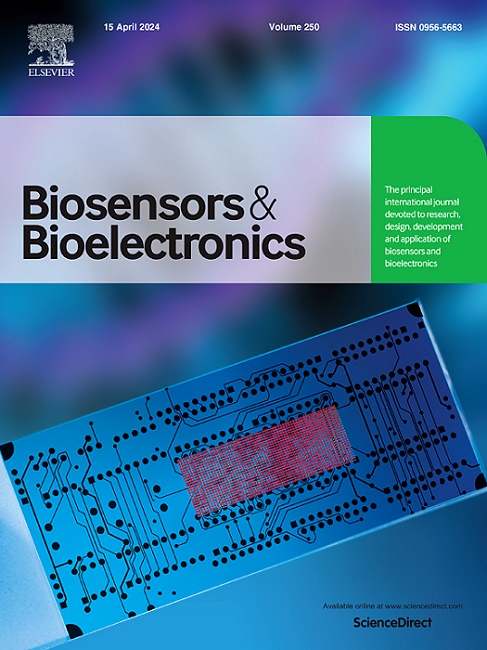Multidimensional surface-enhanced Raman scattering biosensor integrated convolutional neural networks for accurate bacteria identification
IF 10.5
1区 生物学
Q1 BIOPHYSICS
引用次数: 0
Abstract
Surface-enhanced Raman spectroscopy (SERS) has emerged as a powerful technique for bacterial detection, offering high sensitivity and molecular-level specificity. However, conventional label-free SERS methods relie on the spontaneous adsorption of limited chemical components onto the SERS substrate. Here we developed a multidimensional SERS biosensor capable of capturing more comprehensive information through substrate surface modifications. By employing molecular modifiers with distinct chemical characteristics, we modulated the selective adsorption behaviors of bacterial components, enhancing the diversity of physicochemical interactions at the sensing interface. The physicochemical properties of the nanomaterials were characterized using UV–vis spectroscopy, scanning electron microscopy (SEM), dynamic light scattering (DLS), and zeta potential analysis. A database comprising 119,000 SERS profiles from 17 bacterial strains across seven dimensions was constructed. The 1D-convolutional neural network (1D-CNN) model was utilized to analyze 127 dimensional combinations, achieving a maximum accuracy of 99.29 %. The results demonstrate the capability of the multidimensional SERS biosensor to enhance bacterial identification accuracy by leveraging the rich biochemical diversity captured across multiple dimensions. Nevertheless, optimization of the dimensionality is necessary to mitigate problems such as redundancy and overfitting during data processing.
多维表面增强拉曼散射生物传感器集成卷积神经网络精确细菌鉴定
表面增强拉曼光谱(SERS)已成为一种强大的细菌检测技术,具有高灵敏度和分子水平的特异性。然而,传统的无标记SERS方法依赖于有限化学成分在SERS底物上的自发吸附。在这里,我们开发了一种多维SERS生物传感器,能够通过衬底表面修饰捕获更全面的信息。通过使用具有不同化学特性的分子修饰剂,我们调节了细菌组分的选择性吸附行为,增强了传感界面上物理化学相互作用的多样性。利用紫外可见光谱(UV-vis)、扫描电镜(SEM)、动态光散射(DLS)和zeta电位分析表征了纳米材料的物理化学性质。构建了一个包含17种细菌菌株在7个维度上的119,000个SERS图谱的数据库。利用1d -卷积神经网络(1D-CNN)模型对127个维度组合进行分析,最高准确率达到99.29%。结果表明,多维SERS生物传感器能够通过利用在多个维度上捕获的丰富的生化多样性来提高细菌鉴定的准确性。然而,为了减少数据处理过程中的冗余和过拟合等问题,优化维数是必要的。
本文章由计算机程序翻译,如有差异,请以英文原文为准。
求助全文
约1分钟内获得全文
求助全文
来源期刊

Biosensors and Bioelectronics
工程技术-电化学
CiteScore
20.80
自引率
7.10%
发文量
1006
审稿时长
29 days
期刊介绍:
Biosensors & Bioelectronics, along with its open access companion journal Biosensors & Bioelectronics: X, is the leading international publication in the field of biosensors and bioelectronics. It covers research, design, development, and application of biosensors, which are analytical devices incorporating biological materials with physicochemical transducers. These devices, including sensors, DNA chips, electronic noses, and lab-on-a-chip, produce digital signals proportional to specific analytes. Examples include immunosensors and enzyme-based biosensors, applied in various fields such as medicine, environmental monitoring, and food industry. The journal also focuses on molecular and supramolecular structures for enhancing device performance.
 求助内容:
求助内容: 应助结果提醒方式:
应助结果提醒方式:


